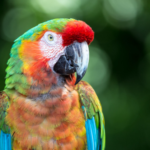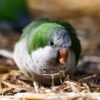- How Long Does A Quaker Parrot Live? - 17 May 2024
- 4 Hacks on Keeping Your Home Clean With Pets - 28 March 2024
- 5 Things to Know Before Bringing Home a New Kitten - 26 March 2024
The fall is a time for bears to accumulate fat stores to survive winter. They will consume more honey and other insects than they would normally during this time. Kinkajous are also known as “honey bears” because of their love of raiding beehives. These cat sized rainforest mammals are related to raccoons and coatis.
Characteristics of Honey bear&Kinkajous

| Aspect | Description |
|---|---|
| Breed Name | Honey Bear (Syrian Hamster) |
| Origin | Syria |
| Appearance | Large, round body; golden or brown fur |
| Size | Average length of 5-7 inches |
| Temperament | Generally docile, solitary nature, can be territorial |
| Care Needs | Proper habitat with bedding for burrowing |
| Socialization | Prefer to live alone, regular handling |
| Lifespan | Typically 2-3 years when well cared for |
| Maintenance | Requires clean environment, fresh water |
Honey Bears have short, thick coats of tan or brown with patches of white around their eyes and in a crescent or bib-shaped patch on their chest. They also have tan to black claws and feet that are adapted for climbing trees. Their snouts are mobile and gaped, adapted to suckering termites and other insects as well as eating a variety of fruit species.
Honey bear Care
A frugivore (fruit-eating), the kinkajou is also known as the honey bear. Their love for honey and their yellow-brown coat have given them this name, along with the fact that they are a nocturnal creature that raids beehives. They are related to raccoons rodent and coatis and are native to Central and South America. Kinkajous breed throughout the year and their young are born blind, hairless, and completely dependent on their mothers. They are polyestrous and females can come in to estrus up to three times per year. They have short digestive tracts, which suggest they are originally descended from carnivores.
They have the longest tongues in the bear family and long, sickle-shaped claws that help them tear into trees and termite mounds. They have a flattened chest and inward-facing feet, which give them a distinctive pigeon-toed walk. Their light patch of fur on the chest is unique to each individual and legend says it resembles the rising or setting sun. Zoos provide enrichment for these bears with pieces of honeycomb that keep them stimulated and active and allow them to show their natural behaviors.
Common Health Problems
Although they are solitary animals, sun bears sometimes occur in pairs or small groups (such as a mother and her cub). They are excellent climbers, sun bathe in trees 2 to 7 meters (7 to 23 ft) above the ground, and sleep in them at night. They are omnivores that feed on insects, ants, beetles, fruit, seeds and several kinds of flowers; vertebrates like birds and deer are also eaten.Their light patch of fur on the chest resembles the rising or setting sun, which gives them their name.

Sun bears have a distinctive pigeon-toed walk and powerful forelimbs with large claws for climbing. Their long tails are used as a fifth hand, enabling them to grasp branches and trees. Kinkajous are often seen in apiaries raiding hives for honey, earning them the nickname “honey bear” even though they are not related to bears. They are members of the family Procyonidae and more closely related to raccoons. Their long tongues can reach deep inside flowers to collect the nectar.
Diet and Nutrition
A bear is a omnivore, meaning they consume both plant and animal foods. Their diets can include grass, berries, mushrooms, roots, nuts, insects, small mammals like mice, fish and carrion. They also require a high amount of protein for survival in the wild, so when bears find beehives they are often willing to raid them and eat the honey inside
Winnie the Pooh is a beloved character, but did you know that real Canadian bears inspired A.A. Milne? Winnipeg Bear, a black bear from White River, Ontario, was the inspiration for the character. The bear is known for his love of honey and for damaging bee hives, which prompted the Ontario Government to establish a program that compensates beekeepers for damages caused by eligible wildlife species including bears, deer, raccoon and skunk.
Is Honey bear adopting Pet?
In the wild, kinkajous indulge in a variety of fruits and berries. They also eat insects, and they’re able to climb trees with ease thanks to their long, sickle-shaped claws. They’re nocturnal and their long tongues extract honey from bee nests, which is how they got their “honey bear” nickname. Kinkajous are a close relative of raccoons and coatis, and they can be very curious arboreal exotic pets when raised in captivity. These bears are a little smaller than the American black bear and weigh about half as much.
They’re one of the few bear species that don’t hibernate, because they live in tropical regions where food is available year-round. This omnivorous species is often seen foraging on the ground, but they’re more likely to be in the trees. They’re polyestrous and females breed throughout the year. They may become sexually mature at 2 to 4 years of age. They’re very curious animals and can make great companions. They’re very social and love head scratches. They’re also very calm and affectionate.
More Honey bear and Further Research
Honey bear animal is a sweet, viscous substance that’s the end result of the lifetime work of bees. It’s a tasty treat and has medicinal properties. And it’s easy to store for decades. But why do so many brands sell it in cute bear-shaped bottles?The sloth bear (Melursus ursinus) is a forest-dwelling bear that lives in tropical or subtropical regions of India and Sri Lanka. The nocturnal animal has poor senses of sight and hearing but can detect a predator with its strong odor. It uses its long, curved front claws to dig up and break open insect colonies.
Sun bears are the smallest members of the bear family, occurring only in tropical forests in Southeast Asia. Females typically raise one or two cubs per litter and are known to walk erect with their cubs in their arms for short distances. Sun bears have distinctive orange to cream-colored chest patches and unique morphology, including inward-facing feet, flattened heads and powerful forelimbs with large claws that are used to climb. They also have long tongues that help them forage for insects and fruit.
Human Honey Bear Conflict
Despite their intelligence and curiosity, bears can easily get into trouble with humans. Their powerful noses, dietary flexibility and voracious appetites mean they quickly discover – and readily investigate – potential sources of calories in or near human habitations such as campgrounds, cabins, homes and urban areas. Once they associate these places with food rewards, they are likely to return and may become habituated, resulting in repeated conflict. Researchers have found that reducing bear-human conflicts is possible. For example, Heather Johnson, a Colorado Parks and Wildlife researcher, crawled into 190 bear dens to place radio collars on hibernating females and their offspring.

Her favorite subject, B7, was a fearless mother who ate so much garbage that she popped her radio collar off her neck and showed up at a barbecue Johnson attended. Other ways to reduce bear-human conflicts include removing attractants such as bird feeders, trash, grills, and pet care foods from your home and properly storing them. Contact your MassWildlife district office for advice on securing and removing these attractants. Electric fences are another option to deter bears from raiding unsecured chicken coops or other structures like beehives.
Honey Bear Growth in worldwide
Increasing awareness of honey’s health benefits and hike in demand for natural sweetener are expected to boost market growth. However, increasing use of sweetening alternatives may hinder market growth. The kinkajou is the New World version of the bear, with bare hands and feet, a prehensile tail and an appetite for honey. These nocturnal mammals are found in rainforest areas in Central and South America. They are related to raccoons, red pandas and monkeys, but have soft, honey-colored fur.
The purchase of the packing and cold storage facility will allow Honeybear to increase apple and cherry production in the ideal growing region of northern Washington, ensuring consistent delivery to its retail and export partners. Located in Pateros, the facility will complement existing processing and packaging capabilities at Honeybear’s state-of-the-art plant in Brewster, WA.
Reproduction and Life Cycle
Typically, black bears are solitary creatures except for family groups (a mother with cubs). Mating season occurs in May and June, but the fertilized eggs – called blastocysts – do not implant in the female’s uterus until fall, at the start of her denning season. This delayed implantation allows the female to’sense’ whether she has enough fat reserves and energy to carry a pregnancy to term.
Females give birth in late December or January during their winter den. Litter size is usually two cubs. The mother and cubs are close and she will guard them for up to a year before she breeds again. The male does not help rear young. The kinkajou is one of the few mammals that is not a hibernator and it has a long tail which they use as a fifth hand for climbing.
Honey Bears in Captivity
Honey bears are important in zoos or sanctuaries where they play an essential role in education, conservation and research. Zookeepers work diligently to maintain healthy and robust captive populations of this endangered species. In the wild, kinkajous eat lizards, little birds, rodents, termites, insects and fruit. They are also known to use their long tongues to swipe honey directly from a beehive.
Despite their cute appearance and playful personalities, they are dangerous animals in the wild and should not be kept as pets. They can be very aggressive and are easy to startle, as well as high-maintenance and expensive to care for. They also require a diet that closely resembles their natural one in the rainforest. And, of course, they cannot hibernate like other members of the Procyonidae family (raccoons, coatis and olingos). This makes them unsuitable for most people to keep as pets.
Role in Zoos or Sanctuaries

Unlike zoos, animal sanctuaries do not put visitors before animals. Their mission is to care for rescued/rehabilitated animals and to educate people on animal rights and conservation. They are also not involved in the commercial trade of animals or their offspring. They do not breed animals, but rescue and rehabilitate injured, ill, or unwanted wild animals including domestic pets. They may use these animals as ambassadors to educate people on animal welfare and promote conservation efforts.
They also help to fund wildlife projects in their home countries and abroad. They may also provide information on local legislation and regulations to combat the illegal wildlife trade. Anthropomorphism is used to increase visitor-animal connection, but this can reinforce perceptions that animals are kept in captivity, especially when referring to solitary species like kinkajous.
Image source : Medium.com
Wrap up
Honey Bears are fascinating animals but can be challenging to care for. Their specific needs including a suitable habitat and a varied diet require dedicated attention and commitment. As pets they may not be suitable for everyone due to their specialized care requirements and nocturnal nature. Potential owners should thoroughly research and be prepared for the responsibilities of caring for these unique creatures before considering them as pets
















